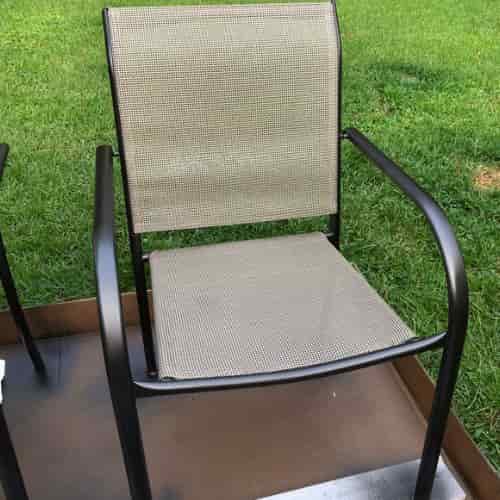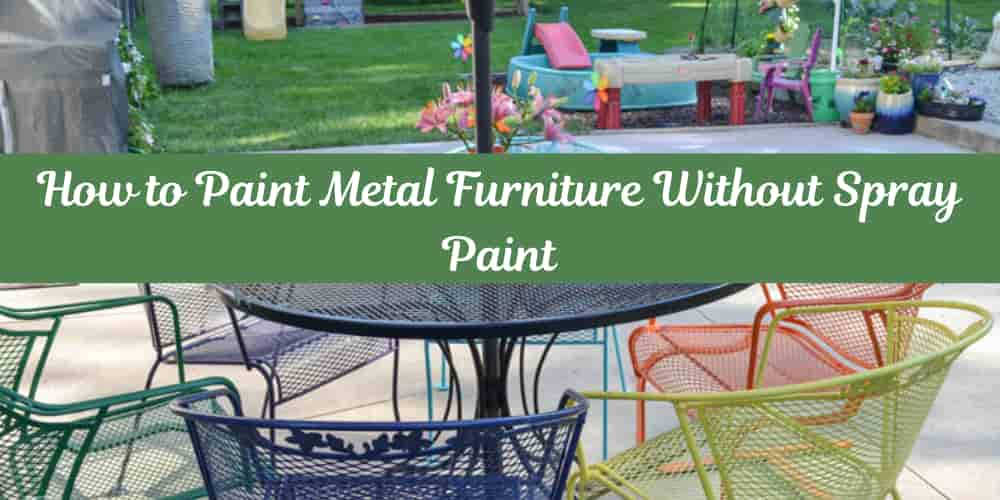Painting metal furniture can refresh its look and increase its lifespan. Using a brush or roller allows for more control and precision, especially in intricate areas. Start by thoroughly cleaning the furniture to remove any dirt, rust, or old paint.
Sand the surface to create a smooth base for the new paint to adhere to. Choose a high-quality, metal-specific paint to ensure durability and a professional finish. Apply multiple thin coats, allowing each to dry completely before adding the next. This method ensures a lasting, attractive finish without the need for spray paint.
Preparing Metal Furniture
Before you start painting metal furniture, proper preparation is key. Ensuring a clean and rust-free surface will help the paint adhere better. This will lead to a more durable finish. Follow these steps to get your furniture ready for a flawless paint job.
Cleaning The Surface
Start by cleaning the surface of your metal furniture. Use a mild detergent mixed with warm water. Dip a sponge or cloth into the soapy water. Scrub the metal surface to remove dirt and grime.
Rinse the furniture thoroughly with clean water. Make sure to remove all soap residues. Dry the furniture completely using a clean towel or cloth. Any moisture left can cause rust to form.
| Cleaning Supplies | Purpose |
|---|---|
| Mild Detergent | Remove dirt and grime |
| Sponge or Cloth | Scrub the surface |
| Clean Water | Rinse off soap |
| Clean Towel | Dry the furniture |
Removing Rust
Rust can weaken your metal furniture. Removing it is crucial before painting. Use a wire brush to scrape off loose rust. For stubborn rust, use sandpaper or a sanding block. Work in circular motions for the best results.
If the rust is extensive, consider using a rust converter. Apply the converter according to the instructions. It will neutralize the rust and turn it into a paintable surface.

After removing rust, wipe the surface with a damp cloth. This will remove any dust and debris left from sanding. Let the furniture dry completely before you start painting.
- Use a wire brush for loose rust.
- Sand stubborn rust with sandpaper.
- Apply rust converter for extensive rust.
- Wipe the surface with a damp cloth.
- Let the furniture dry completely.
Choosing The Right Paint
Painting metal furniture without spray paint requires careful selection of the right paint. Choosing the best paint ensures durability and a beautiful finish. Let’s explore the types of paint and how to pick the perfect color for your project.
Types Of Paint
There are several types of paint suitable for metal furniture. Each type has its own benefits. Here are the most popular options:
- Oil-Based Paint: This paint is durable and long-lasting. It provides a smooth finish.
- Acrylic Paint: Acrylic paint is water-based and dries quickly. It is easy to clean up.
- Enamel Paint: Enamel paint is hard and glossy. It is resistant to scratches and stains.
Consider the environment where the furniture will be used. This helps in selecting the best type of paint.
Color Selection
Choosing the right color can transform your metal furniture. Here are some tips:
- Match with Existing Decor: Ensure the paint color complements your room’s decor.
- Consider the Furniture’s Purpose: Use bold colors for statement pieces. Choose neutral colors for versatile pieces.
- Test Samples: Always test paint samples on a small area first.
Below is a table summarizing the paint types and their key features:
| Paint Type | Key Features |
|---|---|
| Oil-Based Paint | Durable, smooth finish |
| Acrylic Paint | Quick-drying, easy cleanup |
| Enamel Paint | Hard, glossy, scratch-resistant |
Choosing the right paint ensures your metal furniture looks great and lasts long.
Gathering Necessary Tools
Painting metal furniture without spray paint needs careful planning. The right tools are essential. Here’s what you need to gather before starting.
Brushes And Rollers
Brushes and rollers are crucial for a smooth finish. Choose high-quality brushes to avoid bristle loss. Use foam rollers for even paint application. Here is a list of what you should have:
- High-quality bristle brushes
- Foam rollers
- Detail brushes for small areas
Brushes help with detailed work. Rollers cover large areas quickly. Ensure you have different sizes for different parts of the furniture.
Protective Gear
Protective gear keeps you safe while painting. Always wear a mask to avoid inhaling fumes. Gloves protect your hands from paint and chemicals. Here’s a list of the protective gear you need:
- Face mask
- Gloves
- Old clothes or a painting apron
Old clothes or a painting apron prevent paint stains. Always work in a well-ventilated area for safety.
Priming The Surface
Before painting metal furniture, priming the surface is crucial. This ensures the paint adheres well and lasts longer. Let’s explore why priming is necessary and the best primers for metal surfaces.
Why Prime?
Priming the metal surface offers many benefits:
- Prevents Rust: Primer creates a barrier against moisture.
- Enhances Adhesion: It helps the paint stick better to the metal.
- Smooth Finish: Primer covers imperfections and provides a smooth base.
Best Primers For Metal
Choosing the right primer is key. Here are some top options:
| Primer Name | Features |
|---|---|
| Rust-Oleum Clean Metal Primer | Prevents rust, easy to apply, quick-drying. |
| KILZ Original Primer | Blocks stains, excellent adhesion, versatile use. |
| Zinsser Bulls Eye 1-2-3 | Water-based, rust-inhibitive, great for indoor and outdoor. |
Using the right primer ensures a durable and beautiful finish. Don’t skip this step!
Applying The Paint
Painting metal furniture without spray paint can be fun. Using brushes and rollers, you can create a smooth, even finish. Let’s dive into the techniques for applying paint properly.
Techniques For Even Coating
Brushes are ideal for detailed areas. Rollers cover larger surfaces quickly. Use a high-quality brush to avoid brush marks. Dip the brush into the paint lightly.
- Always paint in one direction.
- Use long, even strokes.
- Avoid overloading the brush.
For larger areas, use a foam roller. Foam rollers provide a smooth finish. They reduce the risk of streaks.
- Pour paint into a tray.
- Roll the roller in the paint evenly.
- Apply the paint in thin layers.
Layering And Drying
Layering the paint ensures a durable finish. Apply the paint in thin layers for best results. Follow these steps for layering:
- Apply the first coat thinly.
- Let it dry completely.
- Sand lightly with fine-grit sandpaper.
- Apply the second coat.
- Repeat the process as needed.
Drying time is crucial. Allow each layer to dry fully before adding another. This prevents smudging and uneven textures. Check the paint can for specific drying times.
For best results, paint in a well-ventilated area. Ensure the room temperature is suitable. This helps the paint dry evenly.
Finishing Touches
After painting your metal furniture, the next step is crucial. The finishing touches ensure durability and add visual appeal. Let’s explore how to seal the paint and add decorative elements.
Sealing The Paint
Sealing the paint protects your hard work. It makes the furniture last longer. Use a clear sealant designed for metal. Follow these steps:
- Choose a clear sealant suitable for metal surfaces.
- Apply the sealant with a brush or a foam applicator.
- Ensure an even coat covering all painted areas.
- Allow the sealant to dry completely, following the product instructions.
Sealing helps prevent rust and chips. It keeps the paint looking fresh.
Adding Decorative Elements
Make your furniture unique with decorative elements. Small changes can have a big impact. Here are some ideas:
- Use stencils to create patterns and designs.
- Add decals for a personalized touch.
- Attach decorative hardware, like new handles or knobs.
- Use metallic paint for accents and highlights.
Decorative elements can enhance the overall look. They make your furniture stand out.
Here’s a quick comparison table for different decorative options:
| Decorative Element | Effect | Difficulty Level |
|---|---|---|
| Stencils | Patterns and designs | Medium |
| Decals | Personalized touch | Easy |
| Decorative Hardware | New handles or knobs | Medium |
| Metallic Paint | Accents and highlights | Easy |
Get creative and have fun with this process. Your metal furniture will look amazing!
Maintenance Tips
Proper maintenance extends the life of your painted metal furniture. Here are some essential tips to keep it looking fresh and vibrant.
Cleaning Painted Metal
Regular cleaning helps maintain the shine and prevents damage. Follow these steps:
- Use a soft cloth or sponge to wipe off dust.
- Mix mild soap with warm water.
- Dip the cloth in the solution and gently clean the surface.
- Rinse with clean water and dry with a soft towel.
Avoid using abrasive cleaners or tools. They can scratch the paint and expose the metal beneath.
Touch-up Tips
Small chips and scratches can ruin the look. Here’s how to fix them:
- Clean the damaged area with a soft cloth.
- Sand the area lightly with fine-grit sandpaper.
- Apply a metal primer to the exposed metal.
- Use a small brush to apply matching paint.
- Let it dry completely before using the furniture.
Keep a small amount of the original paint for touch-ups. This ensures the color matches perfectly.
| Task | Frequency |
|---|---|
| Dusting | Weekly |
| Deep Cleaning | Monthly |
| Touch-ups | As Needed |
These tips ensure your painted metal furniture stays beautiful. Regular maintenance makes a significant difference.
Common Mistakes To Avoid
Painting metal furniture without spray paint can be a fun project. But, making mistakes can ruin your hard work. Let’s explore some common mistakes and how to avoid them.
Skipping Primer
Primer is an important step in painting metal furniture. Many people skip it, thinking it’s unnecessary. This can lead to peeling and chipping paint.
A primer helps the paint stick to the metal. It also prevents rust and corrosion. Always use a metal primer before painting. This ensures a smooth and durable finish.
| Without Primer | With Primer |
|---|---|
| Paint peels off easily | Paint lasts longer |
| Metal may rust | Metal stays protected |

Using Wrong Tools
Using the wrong tools can make painting metal furniture difficult. Brushes with stiff bristles can leave marks. Rollers may not reach small spaces.
- Use soft-bristle brushes for smooth application.
- Choose small brushes for detailed areas.
- A foam roller can help for larger, flat surfaces.
Make sure to clean your tools after use. This keeps them ready for your next project.
Frequently Asked Questions
How Do You Prepare Metal Furniture For Painting?
Clean the metal surface thoroughly. Remove any rust using sandpaper. Apply a metal primer to ensure paint adhesion.
What Type Of Paint Is Best For Metal Furniture?
Use oil-based or acrylic paint designed for metal surfaces. These paints provide durability and a smooth finish.
How Many Coats Of Paint Are Needed?
Typically, two coats of paint are sufficient. Apply the first coat, let it dry, then apply the second coat.
Can I Paint Metal Furniture Without Sanding?
It’s best to sand for better adhesion. If you skip sanding, use a high-quality primer to ensure paint sticks.
Conclusion
Painting metal furniture without spray paint is simple and rewarding. You can use brushes or rollers for a smooth finish. Choose the right paint for durability and aesthetics. Follow our steps for a professional look. Enjoy your refreshed furniture and the compliments it will bring.
Happy painting!
